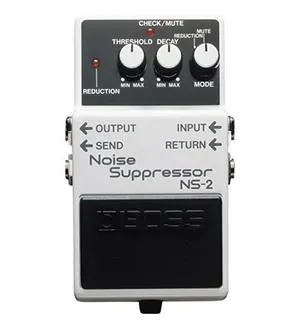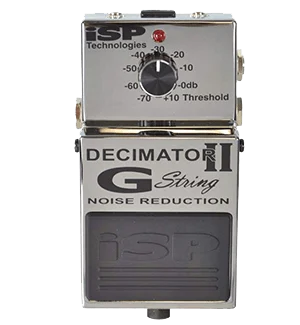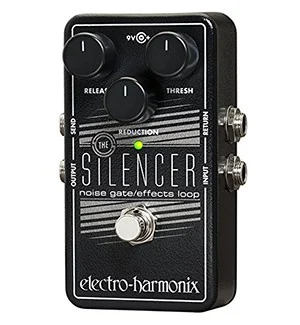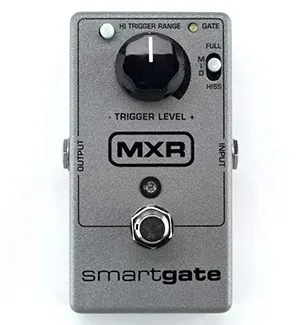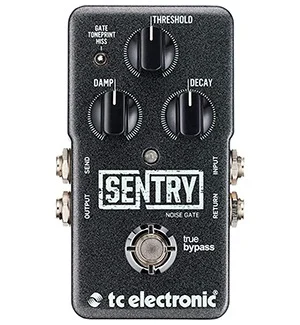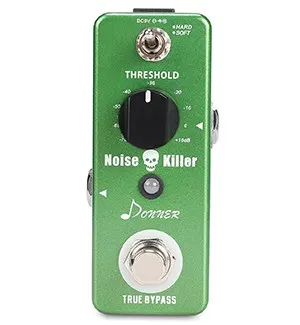The best noise gate pedal has one and only one job to do, but does it perfectly, and that is to suppress as much hum and hiss out of your guitar’s signal as possible. If you still hear a problem after using one of these noise-busters, you have bigger issues somewhere else, because these are the top of the line…
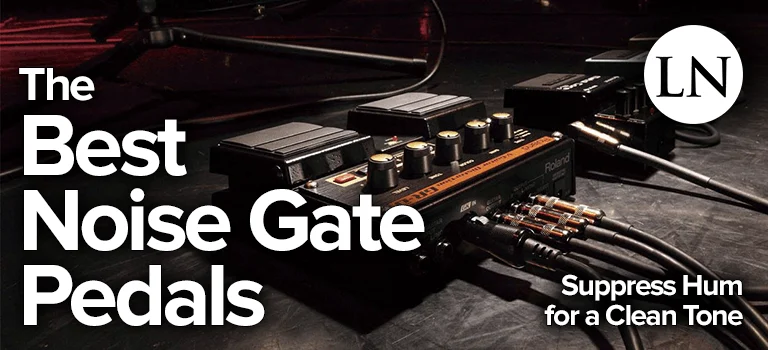
Electrical problems can plague guitar players. The 60 cycle hum and other ground noise issues can be devastating to a performance or recording.
Most of the time you can’t do anything about bad power at a venue.
If a problem develops within your guitar or your other gear while you’re live on stage, there’s nothing you can do, unless you have a noise gate pedal on your pedalboard. And in that case, you’re good to go as long as you’ve set it up before hand.
Noise gates have had their place in the recording studio for the longest time, especially during the mixing process. It’s only right and was inevitable that we’d get them in stompbox form due to their incredible usefulness.
Regardless if you’re using one in true bypass mode when unneeded or with noise suppression engaged, the result is that all of the lower volume (but still audible) hum and hiss will be removed from your signal when you’re not actively playing. It’s an instant upgrade for you that your entire band will benefit from.
Need more information in order to better understand your needs? We have got you covered! Visit our FAQs section.
INCLUDED IN THIS GUIDE:
| BOSS NS-2 NOISE SUPPRESSOR | Best Bang for the Buck | Buy on Amazon |
| ISP TECHNOLOGIES DECIMATOR II G STRING | Best of the Best | Buy on Amazon |
| ELECTRO-HARMONIX THE SILENCER | Best Budget Pick | Buy on Amazon |
| MXR M135 SMART GATE | Best Noise Pedal for Setting the Threshold | Buy on Amazon |
| TC ELECTRONIC SENTRY NOISE GATE | Best at Targeting Frequency Ranges | Buy on Amazon |
| DONNER NOISE KILLER | Best for Noise Reduction | Buy on Amazon |
BOSS NS-2 NOISE SUPPRESSOR
Our “Best Bang for the Buck” pick goes to the Boss NS-2 Noise Suppressor pedal. This beast is simple in operation and does it’s job perfectly.
First you’ll note the Mode knob that gives you the option of a full mute when your signal dips below the threshold or a volume reduction to simply quieten the noise and hiss. What’s nice here is you get to shape the tail of your envelope by choosing how long you want to allow your notes to decay.
Beyond that all you do is set the threshold. This lets the pedal know when to begin it’s attack and stop muting or reducing the signal. The attack is very fast, meaning that as soon as your pick hits the string it stops so your notes ring out completely naturally. Some are too slow and chop off the starts of your notes. That’s a no-go.
None of the pedals on this list do that, but the Boss NS-2 is particularly fast. You’ll never know it was there in this respect. It’s transparent, suppresses noise, and attacks fast. What more can you ask for.
Boss builds a tank of chassis with huge switches, and that’s what you get here. You also get an effects loop if you’d rather do that, then feed the end result to your amplifier. This ensures that your final signal has no noise, versus using it in serial.
Specs:
- Product Dimensions: 9 x 4 x 6 inches
- Signal Format: Analog
- Voltage: 9 V
Pros:
- Extremely durable
- Acts as a power supply for other pedals
- Delivers precise tone
Cons:
- Might color your sound a bit
- A tinge of tone suction might be present
ISP TECHNOLOGIES DECIMATOR II G STRING
It’s rare that there’s ever a clear leader in a market but the ISP Decimator II G String noise reduction pedal takes the cake easily. Look at the face of the pedal.
You get a huge switch (no missing a tiny one in the moment when it counts), a very sturdy case, and a single knob. This knob allows you to set the threshold where you like it, which also is how you’ll set the length of the decay of your notes.
There’s some non-obvious features that put this one in the leader slot. For one, it tracks the input of your signal and will detect if you move from a clean, low gain signal to a hot one and will adjust the threshold to match your original setting.
It also has a linking function where you can place two Decimators together for a stereo signal. The linking matters because you want both mono channel’s noise reduction firing at the same time.
This is the same “gain tracking” technology they use in their highly rated ProRack G system. The attack is fast, the release doesn’t bite your note’s tail off too soon, and of course it’s noiseless, which is the whole point. It’s one of the few “smart gates” that does so without surprises.
The entire guitar community is backing this pedal. It’s the obvious choice for the serious player, where quality is everything. It’s definitely the current best noise gate pedal.
Specs:
- Product Dimensions: 6 x 3 x 2.5 inches
- Signal Format: Analog
- Voltage: 9 V
Pros:
- Straightforward noise reduction pedal
- Great sound quality
Cons:
- One of the most expensive items on our list
ELECTRO-HARMONIX THE SILENCER
Usually our “Best Budget Pick” goes to a cheap overseas option like Donner or Behringer, but in this case the Electro-Harmonix The Silencer wins easily. Not only is it as inexpensive but it features a noise gate and an effects loop, all with superior EHX circuitry. This circuitry includes three knobs: Release, Threshold, and Reduction.
Unlike others here, which largely just let you control the threshold, this one lets you choose exactly how much noise reduction you want. Most are either a static amount of reduction or a complete muting of the noise.
This is a very welcomed feature so your decay is never chopped off entirely but simply reduced in volume. Of course, where you set it depends on how much noise you’re currently experiencing, but the choice is always nice. This reduction can go as far as -70 dB (which is basically ‘mute’).
You get to set the release as well, so when the signal amplitude dips below the threshold, it waits before it reduces the noise. This waiting period can be set between 8 milliseconds (immediate) or as long as 4 seconds if you want some really long sustain. The send output can work as an effects loop or as a signal splitter.
The outputs are buffered and so is the bypass, which isn’t true bypass but you’re not going to get any noise out of a noise gate anyways, and this one is as transparent as they come. Check it out, it’s a top notch option.
Specs:
- Product Dimensions: 4.5 x 2.75 x 2.1 inches
- Signal Format: Analog
- Voltage: 9 V
Pros:
- Adjustable threshold reduction
- Release control change
- Works with both battery and power supply
Cons:
- May kill sustain when holding a note
MXR M135 SMART GATE
MXR has done something really special with the MXR Smart Gate M135. It’s not “smart” in the way the IPS Decimator II above is, but is smart in its own way. It features “Intelligent Gating” that analyzes the speed of your pick attacks to know how fast it should react, allowing your attacks to come through cleanly. In this same way it knows if it should lengthen the decay for sustain if you aren’t picking as frequently.
This beast can handle high gain, single coil pickups, and all other types of noise, and does so transparently. The big knob called “Trigger Level” is how you set the threshold. The Hi Trigger Range button is for line level instruments like keyboards and synthesizers. It also has a hardwired true bypass.
The best part of this pedal is the switch on the right that allows you to target specific types of noise. Hiss is for high frequency noise, Mid is for the kind of noise you get out of your amp, and full attacks the entire frequency spectrum, taking care of hum, hiss, and buzz. That’s cool, especially for a bassist with hiss or a guitarist with buzz.
The attack is extremely fast so you never lose any transients and those sweet harmonic overtones you get during picking. Slap this just after your guitar or even at the end of your signal chain for high gain and distortion, and you’ll never hear noise again.
Specs:
- Product Dimensions: 5.8 x 4.5 x 2.8 inches
- Signal Format: Analog
- Voltage: 9 V
Pros:
- Works with both battery and power adapter
- Features a true bypass
Cons:
- A little bit expensive
TC ELECTRONIC SENTRY NOISE GATE
The only pedal on the list that features multiple modes is the TC Electronic Sentry Noise Gate. The first mode is a multiband mode that targets noise separately by frequency range. That’s a great addition, especially for bassists who can drop out high frequency hiss and hum without affecting their sustain.
It works for guitarists too who can kill low frequency buzz while maintaining their own sustain. This algorithm is the same as in their acclaimed System 6000 mastering processor.
You also get a classic “hard noise gate” mode that we all know and love. You can side chain effects with the send & return jacks for an effects loop. You can choose from a buffered bypass or true bypass with an internal dip switch. And it’s built like a tank. Most people like fully analogue solutions but for a noise gate I prefer digital tech, like the multiband mode.
Like all current TC Electronic pedals, you can download presets created by professional players through your computer or beam it through your pickup straight the the pedal through your cable. I think this TonePrint tech is so wild. You can choose these presets and modes through the switch on the top left.
This is a great option for the person moving into a more modern setup and foregoing all of the vintage pedals and boutique pedals.
Specs:
- Product Dimensions: 5 x 3 x 4 inches
- Signal Format: Analog
- Voltage: 9 V
Pros:
- Allows you to tweak as much parameters as possible
- Does not color your tone
Cons:
- Little guidance on how to use the pedal
- Might be a bit too much for some users
DONNER NOISE KILLER
If you can tack on an extra $20, then I recommend going with the Electro-Harmonix The Silencer above. But if your budget is extremely tight then you’ll still be satisfied with the Donner Noise Killer, especially with it’s nano size. Mini pedals eat up little room on your pedalboard and there’s no need for a huge noise gate anyways.
This little bad boy can reduce noise up to 70 dB and is absolutely transparent. People use it right after the guitar and at the end of the effects chain too, especially for distortion. You get to choose between two modes, one being a soft knee and the other a hard knee.
The difference is a subtle, gradual (but still quick) reduction of noise and the other is obscenely fast. Beyond that, all you want to do is set the threshold for the correct levels.
This is the cheapest pedal I’d suggest. Anything less and you’re sacrificing quality. With Donner you always get great quality with price savings from overseas manufacturing. I know people using this one for guitar, harmonica, and even a goofy dude running his headphones through it. It works well and can save you a good chunk of space on your pedalboard and a handful of dollars in your wallet.
Specs:
- Product Dimensions: 5 x 2 x 2 inches
- Signal Format: Analog
- Voltage: 9 V
Pros:
- Affordable price for a reliable pedal.
- Small size to make room for other pedals on a pedalboard.
- Intuitive and easy operation of the threshold parameter.
Cons:
- Audible clicking sound when the pedal is engaged.
FAQs
In this section, we’ll look at exactly what a noise gate does, how it does it, and the features you should be looking for when you start considering a purchase. By reading this short discussion, you’ll be fully equipped to make an informed decision, and that’s when we’ll get you started with our top recommendations from today’s current and modern line-up. Let’s do this.
What is the Noise Gate Effect?
The noise gate effect works like a combination of a compressor and an all-pass filter on an equalizer. The problem is equalizer pedals don’t have all-pass filters, so you need this additional tool in your arsenal. And without it a compressor pedal can make your noise more noticeable.
The end result of using one is that, for a guitar for example, your amplifier will only output sound when your guitar is actively being played. Otherwise, all electrical noise and hum and other low volume sounds will be blocked out.
This effect is used by mix engineers on nearly every track, whether done manually or with a noise gate plugin, on every song these days. Even if every track has inaudible amounts of noise that you’d never notice when solo’d, when combined this noise can add up and be heard, muddying up the song in its final mix.
By setting a very precise threshold level below which no audio can pass through, you can ensure you won’t be emitting any buzzing noises out of your amplifier between songs, and if set extremely carefully you can make sure there’s no extra noise even between notes or phrases.
Often people will forego the benefits because they’re too lazy to set it up (yes, you need to reset it up each time and in each location depending on how you’re playing that day or that hour), but having this pedal early in your set up offers a clean feed to your other effects and amplifier that everyone will appreciate.
What to Look for in the Best Noise Gate Pedal?
The most important aspect of a noise gate is accuracy. While you can’t test every pedal out there, you can read reviews and make sure nobody is complaining about this. Accuracy relates to how quickly the effect kicks in when the amplitude of your guitar or other instrument dips below the threshold.
If you can’t set and trust a precise value, then noise will sneak through. If you’re playing metal or any other genre or distortion effect with huge amounts of gain this can be problematic.
Other than that, you’ll likely want a transparent gate that adds no coloration or extra flavors to your tone. Let your other pedals handle that.
You may see pedals with a lot of options on it for the attack and release of the noise gate, you can trust the manufacturers to have set pleasing values there, which is why you see a lot of pedals with nothing more than a threshold knob.
Those tend to be perfectly fine. This isn’t a complicated effect, you just need to be able to set the threshold and trust that it’s working accurately.
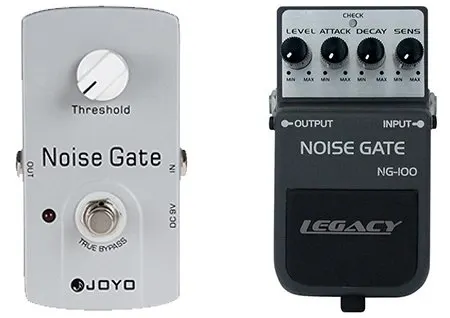
How to Use a Noise Gate Pedal
With a noise gate you don’t have to worry about the complications of an effects loop or the signal chain in general. You obviously want the gate to come early so the rest of the effects aren’t acting on any noise that would have otherwise snuck through. Let’s look at this logically.
Where to Place it in the Signal Chain
By looking at the sequence of the effects chain it becomes obvious where you want your gate to come among all of your other types of guitar pedals and why you should place it there:
- Dynamics, Filters, & Pitch Shifters
- Boost & Distortion
- Modulation
- Time
Noise gates are a form of dynamic control and should come at the very front of your signal chain, even before compression, though you can place it afterwards if you’re concerned about having a lot of sustain.. You typically want all noise out of your signal before other effects start acting on it.
Understanding the Knob Settings
These are the easiest pedals to understand, but not to use. Most only feature a Threshold knob which is the volume level below which everything is silence.
Others will let you control the Release or Decay so you get a smooth transition back into the main signal, although most manufacturers set the attack and release for you, which tends to work out just fine. Others with Mode knobs will let you move from a complete muting of noise to just a reduction to save you from any abrupt sound changes.
